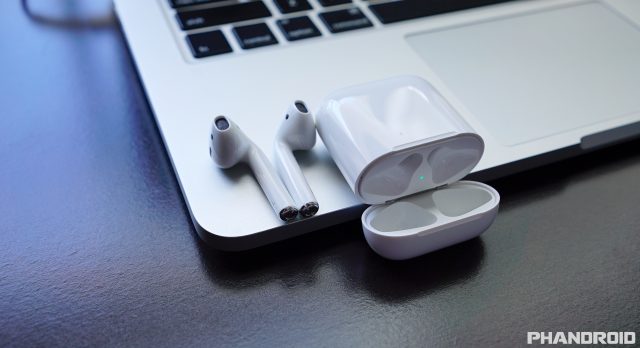Google Pixel Buds vs Apple AirPods: Which is the best option?
Google’s response to Apple’s AirPods has finally arrived, but it wasn’t exactly what we were expecting. The Google Pixel Buds look to be the answer to the AirPods in terms of functionality and ease of use, but how do these headphones really compare to one another?
We’re going to take a look at which option is best for you, regardless of which device you’re using. From there, we’ll be able to determine whether you should spring for the Pixel Buds or AirPods when the Pixel Buds launch later this year.
Price: Tie
Getting the biggest hurdle out of the way first, there’s not much comparison between these two options, as the AirPods and Pixel Buds are both priced at $159. The only problem currently lies in availability, since the Pixel Buds won’t be launching until November, and that’s if Google doesn’t run into any supply issues.
While there are plenty of “budget” Bluetooth headphones on the market, that’s not the market that Apple or Google is shooting for. Both options are aimed for those who want the complete experience from top to bottom, and everywhere in between, and that’s what each option provides, as long as you are a part of that ecosystem.
Battery Life: Tie (For now)
The biggest point of contention when it comes to our smartphones or Bluetooth headphones is battery life. Who wants to deal with recharging their headphones after using them for just an hour or two?
Samsung struggled with this with the first iteration of the Gear Icon X headphones, but it seems that Apple and Google may have things figured out. Both the AirPods and Pixel Buds are rated for up to 5 hours of use with each charge.
Then with the accompanying charging case, Apple and Google both claim that their charging cases will provide up to 24 hours of battery life for the headphones, before needing to recharge. That’s a pretty wild claim, but in my time with the AirPods it definitely holds up.
Speaking of charging, Apple claims that the charging the AirPods for just 15 minutes will give users up to 3 hours of extra battery life. As for the Pixel Buds, Google claims that 15 minutes of charging will give users an extra hour of battery life. Obviously Apple gets the nod here, but mileage may vary if you’re only using them with an Android device which doesn’t take advantage of Apple’s W1 chip.
Considering the fact that the Pixel Buds aren’t released yet, we’ll have to wait and see if Google’s claims hold up over time.
Completely Wireless: Apple AirPods
Over the last few years, we have seen a stronger effort from OEM’s to provide completely wireless Bluetooth earbuds, but there haven’t really been any options that stuck. That was the case until the AirPods were released.
This showed that it was entirely possible and that you could have enough battery life to last you throughout the day, and then some. That’s a far cry from the aforementioned Gear Icon X earbuds launched last year which only held a charge for an hour or two.
However, Google decided to go a different route for some reason and decided to give everyone a cable that stretches across both earbuds. This cable is braided, which should help withstand the daily grind of using and wrapping them back up, but it also serves another purpose.
The cable can be adjusted to help make sure that the earbuds rest comfortably in your ear, without worrying about them falling out during use. When you are done using them, you can either pull the cable tight, or just leave it until the next time you’re ready to rock out. When it comes to the AirPods, this isn’t the case, as Apple just went with the “hopefully your ear fits, if not, oh well” approach.
Connectivity: Tie
This is my favorite feature about the AirPods and I can’t explain how excited I am to see something similar coming from Google. When you open the AirPods for the first time around your iPhone, a prompt appears asking for you to connect them.
According to Google, similar functionality will be coming to the Pixel Buds, meaning that as soon as your case opens, you’ll be able to connect to your device with just a click of a button. This is HUGE as it removes the need to go through and deal with the annoying pairing process that owners of Bluetooth headphones have to currently deal with.
The best part about the Pixel Buds is that this functionality will not be limited to the Pixel 2/2 XL. Instead, you’ll need a device running at least Android 6.0 Marshmallow and have Google Assistant installed on the device. Which, conveniently enough, just made its way onto the Play Store as a standalone app.
Verdict: The answer is obvious
You don’t really think we would recommend the AirPods for someone looking for “flagship” Bluetooth earbuds, do you? Of course not. The AirPods are definitely convenient considering the fact that the cables are gone, but you don’t get any extra functionality when using them on an Android phone, as all of the fun stuff is reserved for iOS users.
So, the answer here is obvious. If you haven’t pre-ordered your set of Pixel Buds yet, hit the button below and do so. If you don’t care about pre-ordering, just hang tight until November when the Pixel Buds are set to launch, then go to your local Best Buy or something and pick them up without worrying about waiting for shipping times.
As someone who currently owns AirPods, I seriously can’t wait to get my hands (or ears) on the Pixel Buds to put them through their paces. Let us know what you think and if you’ll be picking up a pair for yourself.


